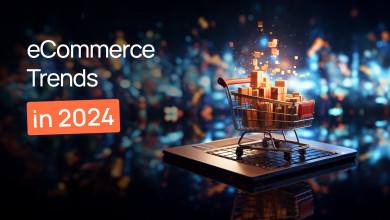Thick fingers.
Yes, you heard that right. We’re starting a guide to Mobile Commerce Trends with this very important piece of information. And now that you’re sufficiently intrigued, let’s figure out what that means.
The share of Mobile Commerce in all eCommerce business continues to grow.

However 67% of users are dissatisfied with their experience on mobile web because 'links and buttons are too small.' Or, as it's commonly called, the 'fat fingers problem.' Haha.
Among other factors that diminish the enjoyment of shopping on responsive web versions, respondents mentioned:
- limited functionality (e.g., lack of offline support);
- slow loading and performance;
- security issues (like the absence of biometric authentication, which increases the risk of data theft and fraud);
- inconvenient navigation, better suited for larger screens;
- insufficient personalization.
Web versions often lack integration with AI and ML systems that analyze user behavior and suggest the most relevant products (unlike Mobile Apps).
So, if things are so bad and painful, where does the figure of $2.522 billion in m-commerce sales in 2024 come from? From Mobile Apps, of course.
Key mobile commerce trend in 2024: The Rise of mobile apps
Indeed, the key trend is the use of apps rather than responsive design for mobile devices.
Users' devices are becoming more powerful, with enough memory to load hundreds of necessary apps. And while just 3-5 years ago, people were reluctant to install separate software just to order pizza, now it has become the norm.
Branded Mobile Apps address all the major issues of responsive design that we mentioned earlier, and they offer a whole range of other advantages.
Let's compare these two solutions.
|
Criteria |
Responsive Mobile Website |
Mobile Application |
|
Accessibility |
Accessible through any browser without installation |
Requires download from the App Store or Google Play |
|
Updates |
Not required |
Periodically necessary, must be installed by the user. |
|
Functionality |
Limited |
Rich features + integration with internal systems and third-party services. |
|
User Experience (UX) |
Less smooth. May suffer due to browser and screen limitations. |
More convenient interface, specifically designed for mobile devices. Faster and more interactive UX. |
|
Speed and Performance |
Delays due to internet speed and device performance. |
Fast loading and operation thanks to optimization for the specific device. |
|
Personalization |
Extremely limited. |
High, thanks to user data utilization and AI/ML integration. |
|
Security |
May have vulnerabilities due to open access. |
More secure, using built-in security features of the operating system. |
|
SEO and Visibility |
Easier to index in search engines, improving SEO and organic traffic. |
Harder to promote through traditional SEO methods, dependent on app stores. |
|
Conversion and Monetization |
Lower due to limited user experience. |
High conversion rate thanks to better UX and monetization options (in-app purchases, subscriptions). |
So, if you were unsure which solution to choose and how to tap into Mobile eCommerce Trends, this comparison should make it clear.
Choose a responsive mobile website if: your budget is limited and you want to reach as large an audience as possible, including those who are not willing to download software. This option is suitable for small and medium-sized businesses that don’t yet have the resources for larger investments.
Choose a mobile app if: you aim for deep user engagement, want to increase customer loyalty and retention, and if your business model involves regular purchases and a high degree of personalization. This option is ideal for companies ready to invest in long-term customer relationships.
5 m-Commerce trends that you'll be seeing everywhere this year
500 million downloads on Google Play Store. Over 7.8 million ratings with a 4.8 out of 5 in the Apple App Store. Amazon Shopping isn’t just one of the most popular apps in the world; it’s the 'gold standard' that the entire eCommerce segment aspires to.
"Make it like Amazon made it" is one of the most popular requests we get from clients. Occasionally, they ask for something like eBay. Clients whose businesses are related to clothing and accessories often look to SHEIN for inspiration, while those in the grocery retail niche aim for Walmart. We are attentive to these wishes, but we always remind our clients that we can do even better. After all, not every standardized solution will suit a specific business. You can follow eCommerce Mobile Trends, or you can shape them. © Customer Account Manager Wezom
Regardless, no one will dispute that analyzing Amazon Shopping as a leading trendsetter is a well-founded choice. Let’s examine what aspects of their solutions we can implement in our own projects.
Third-Party mobile payments
Today, about 60% of Americans have used Buy Now, Pay Later (BNPL) services at least once, and 29% use BNPL at least once a month. You might be surprised, but the most popular item purchased through installment payments is not home appliances or modern gadgets—it's clothing.

Therefore, when discussing Mobile Commerce Trends, we can't ignore the Third-Party payments like apple pay feature, which is available on Amazon, SHEIN, other major marketplaces, and even small branded stores.
Users, especially Gen Z, have come to love the experience of 'seamless purchases.'
For businesses, offering Third-Party payments means:
- reducing the number of abandoned carts;
- increasing the average transaction value;
- attracting new customers.
So, even if your business offers relatively inexpensive products, don’t overlook integrating BNPL services into your branded app.
Curated Shopping Content on the base of AI
Amazon creates special collections of products based on specific themes: holidays, seasons, and popular trends. For instance, 'Christmas Gifts,' 'Summer Items,' or 'Sportswear.'
However, with the advancement of artificial intelligence and machine learning, these collections are becoming increasingly personalized. For Mary, who searched for a tennis racket last week, there might be a collection of tennis apparel from her favorite brands (based on her past purchase history). For Ben, who bought a grill yesterday, there could be complementary products.
Moreover, a well-trained recommendation algorithm won’t just offer the 'standard set' of items for a grill, like charcoal or tongs. Instead, it will act with much more insight. For example, based on:
- Past experience. If a user frequently buys ingredients for specific cuisines (American/Argentinian/Mexican), the algorithm will suggest products, items, and recipes related to those styles.
- Characteristics of the current purchase. Accessories in a similar price range. For example, grates, trays, and other items that match the dimensions of the grill Ben bought.
- Seasonality. If the purchase is made before a holiday, it could suggest gift baskets with picnic sets. Moreover, the algorithm might remember this transaction and, as fall approaches, offer Ben grill covers and other storage items.
These are just superficial examples of possible recommendations. A real algorithm, tailored to your needs, will use much more complex machine learning models and consider a wide range of factors. Ultimately, it will provide the most accurate and useful recommendations in a way that a human manager might not be able to achieve.

Daily/Hourly Deals
Beloved discounts have also made their way into mobile shopping trends. This is an excellent way to encourage users to open the app more frequently and make impulsive purchases. The benefits for businesses are clear:
- increased conversion rates;
- opportunity to clear out old inventory or unsold items;
- boost in app visits and potential audience.
From a development perspective, implementing Daily/Hourly Deals requires a well-planned strategy and technical support to ensure smooth operation. The process typically involves:
- database creation: setting up a database with product IDs, discount percentages, start and end dates, and times for the promotions.
- server logic: developing a script that regularly checks current offers and updates their status.
- frontend and UX/UI: creating a separate section for daily/hourly deals and implementing a timer, often using JavaScript.
- CMS integration: connecting with the Content Management System to manage and display the deals.
- push notifications or Email Campaigns: configuring notifications to inform users of new deals, which helps attract more traffic.
With proper setup of these deals, online stores can significantly boost online purchases, enhance customer loyalty, and maximize business benefits.
As we mentioned in the article on eCommerce Trends, 76% of customers expect you to enhance their user experience with personalized product recommendations and exclusive discounts. You can read more about it below:
Member Rewards
Mobile commerce opportunities have elevated 'membership programs' to a whole new level. Rewards for each purchase, free items for referring friends, and points for reviews and feedback provide huge marketing opportunities with minimal costs.
Loyalty programs foster a sense of belonging to the brand and create a desire to keep returning (no one wants to lose their accumulated rewards). Customers begin to spend more to accumulate additional bonuses or to gain access to higher tiers of the program. Plus, with a discount or other incentives, a person will think twice about going to a competitor who doesn’t offer anything similar. And all of this happens automatically, based on the same AI algorithms.
One of mobile commerce best practices for organizing Member Rewards is gamification. Exploding fireworks, opening treasure chests, spinning the wheel of fortune, and so on - SHEIN excels at this.
Amazon has taken it a step further by offering mobile phone users a paid subscription to participate in its loyalty program. It’s hard to say which approach is more effective, but it’s clear that Member Rewards are a powerful tool for boosting loyalty and increasing sales in e-commerce.
App IQ
App IQ is a term used to describe the intelligence and analytical data capabilities within applications. In the context of e-commerce and mobile technologies, App IQ helps companies better understand user behavior within apps, including usage frequency, types of interactions, preferences, and other key metrics.

App IQ enhances search functionality by utilizing natural language processing (NLP). It also enables the integration of voice search, which is another significant trend in mobile commerce in 2024.
VR and AR: The Future of mobile commerce is already here
When discussing development trends, nearly every company mentions virtual and augmented reality. These are undoubtedly among the m-Commerce Trends that cannot be overlooked.
However, let’s be honest. In practice, these technologies are still primarily tools for creating unique experiences and conducting memorable marketing campaigns. It’s not accurate to say that having VR and AR is a must-have for modern apps.
AR is used for trying on clothes, makeup, or accessories before purchasing. Apps like 'IKEA Place' and 'Sephora Virtual Artist' allow users to see how furniture looks in their homes or test cosmetics on their faces through their smartphone cameras.
The VR experience is interestingly demonstrated by Alibaba's Buy+ project. The Chinese e-commerce giant allows customers to shop in virtual malls using VR headsets. Customers can 'walk' through the created space, select and examine products in a virtual environment, and even interact with virtual salespeople.
While it's hard to predict the future, it's possible that the situation could change. The use of SDKs and frameworks like ARKit (Apple), ARCore (Google), Unity, or Unreal Engine makes the development of AR and VR applications easier. And what's easy to develop often becomes widespread and popular, especially if it helps solve specific business challenges.
Is Mobile Commerce right for Your Business?
According to Statista, by 2027, 62% of all eCommerce purchases will be made through mobile channels. Are you ready to lose more than half of your potential customers who will prefer mobile shopping? No.
That’s why now is the perfect time to consider developing a branded mobile app or start implementing mobile commerce best practices in your current project to stay ahead in the competitive race.
The future of mobile shopping promises to be innovative and interactive, with a focus on personalization, convenience, and security.
We offer a full development cycle, from concept to launch, using cutting-edge technologies like AI, AR, and voice search. Let’s create an app that will be the cornerstone of your success in the digital world!


